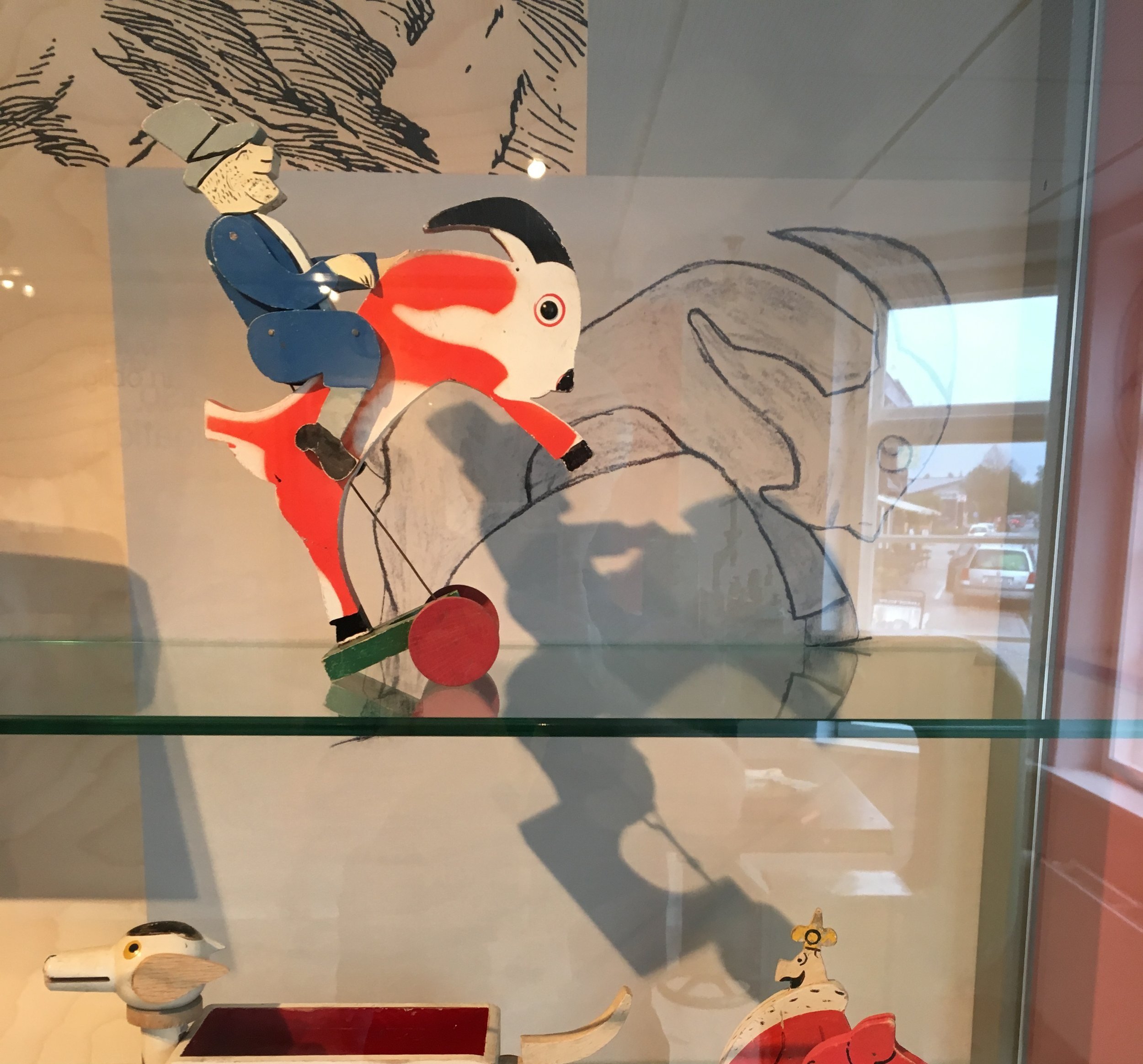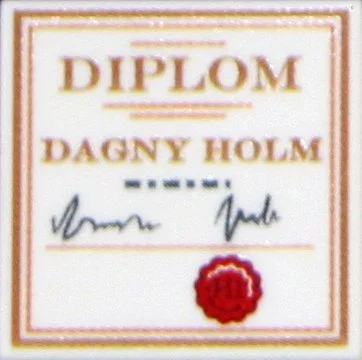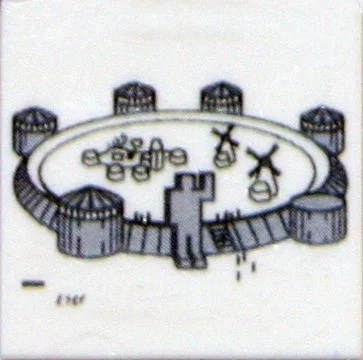LEGO Legacy: A Tribute to Master Builder Dagny Holm
/Ask any Adult Fan of LEGO (AFOL) what their dream job would be and I’ll wager the most common answer would be Master Model Builder. Today, we can all aspire to a job when there are examples of men and women who are already doing that job. But would you tackle creating a new job using a new building medium (LEGO bricks) and taking it to unimaginable possibilities? This is exactly what Dagny Holm did to become the first Master Builder for The LEGO Group.
Via LEGO
via BrickLink
Dagny (pronounced Dow + knee, or Down + y or ie) was recently immortalized in the LEGO House exclusive set 40503 Dagny Holm - Master Builder which included six exclusive printed tiles referencing her incredible talent.
We’ll use these tiles as our roadmap in this article as we explore the life and career of this amazing builder.
Wooden Hangers: Developing Basic Skills
The wooden hangers tile depicts children’s clothes hangers based on sketches prepared by Dagny. She started work as an intern at the company in 1936 at the age of 19. While being the niece of Ole Kirk Kristiansen may have opened the door to working for LEGO, we’ll see that during her career she more than earned a place based on her talents and contributions.



Her artistic skills were evident in the products she created during her three-month internship. Besides the hangers, she designed a red express train, Clumsy Hans (Jack the Dullard) from the Hans Christian Andersen fairytale (more on him later!), and a caricature of the then Danish prime minister Thorvald Stauning. While these early designs by Dagny were all manufactured from wood, little did she know how much the company would change by the time she returned.
Diploma: Refining and Enhancing Skills
Dagny moved to Copenhagen where she would spend the next 25 years. She refined and enhanced her natural artistic talents with an education in classical sculpture at the art school founded by the painter and sculptor Harald Isenstein. Sculpting in clay offered Dagny the opportunity to express herself artistically with no physical limitations from the sculpting medium. Her three-dimensional visualization skills flourished.
Dagny’s life in Copenhagen included an 18‑year marriage to Gustav Jensen. Sadly, Gustav died in 1960, and the following year Dagny Holm moved back to Billund.
Dagny’s return to Billund and the LEGO Group certainly must have taken some getting used to. The era of wooden toys was fading, and the freedom of sculpting with clay was replaced with working with the new rigid plastic rectangular LEGO bricks. Dagny worked with experienced LEGO designer Christian Lasgaard to learn the trade. In the book “Et liv med LEGO” (A life with LEGO) by Jens Andersen, this initial adjustment period was recounted:
"Lasgaard tried to teach Dagny the fundamental ground rules for every LEGO build back in 1961. But square, regular builds don't excite Dagny, who has been working with clay during most of her life. As she later says in the internal magazine: "I had big difficulties getting used to these rigid bricks, but the more you worked with them, the more perspectives you could see."
LEGO showroom 1961 via LEGO
Dagny adapted and persevered. Instead of being frustrated with the new sculpting medium, she applied her visualization talents and started building in ways previously unimaginable.
"She is revolutionizing the design work, which up to that point has revolved around houses, means of transportation and roads, but now she's churning out fairytale characters, animals and landscapes."
Via LEGO
LEGOLAND Concept Sketch: Thinking Big While Building Small
“Necessity is the mother of invention” as the saying goes. This certainly applies to the initial concept for LEGOLAND. By the mid-1960s, the LEGO Group was entertaining 20,000 visitors a year. As the factory and model exhibition gradually found themselves unable to cope with the visitor pressure, Godtfred Kirk Christiansen came up with the idea of a display of LEGO models in the open air. Few could imagine how the first simple concept sketch by Godtfred would be brought to life.
Via LEGO
In 1963, as early plans were being made for the design of a LEGOLAND Park in Billund, there was no doubt who would be given overall responsibility for the creative work. Dagny became responsible for all LEGO model designs of the LEGOLAND Park. Over the next few years, Dagny Holm’s models were built in their oversize elegance with a touch of humor, innovation, and obvious craftsmanship. She built urban settings, castles, animals and fictional characters for LEGOLAND Billund.
Tivoli Train: Timeless Design
In 1967, Dagny was asked to design a LEGO train for the Tivoli amusement park in Copenhagen. She built a small-scale version of the train with a striking red, yellow and black color scheme. The design, built with LEGO elements, was then scaled up to accommodate adult and child riders. After being used at Tivoli during the 1967 season, in November of that year, the train was sent to New York City and made an appearance in Macy’s Thanksgiving Day Parade. The train operated on wheels and tires before being converted to operate on rails when installed in LEGOLAND Billund in 1968.
In 1973 another LEGOLAND Park opened in Sierksdorf, Germany. This park also featured a similar version of the train with the roof of each train coach being given a more rounded appearance. After the Sierksdorf park closed in 1976, the newer and more modern LEGOLAND train was moved to Billund to replace the original LEGOLAND train from 1968.
This enduring train design (lasting 55 years!) was featured in a notable set, the 4000014 LEGO Inside Tour exclusive from 2014. You can read more about it in one of our previous articles. I find it a little amusing to think about the set designers trying to scale down the real train when it had originally been scaled up from a LEGO model! I guess the train design really went full circle!
But this wasn’t the only Dagny-inspired design to end up as a LEGO Inside Tour (LIT) exclusive. Clumsy Hans, originally built as a wooden toy by Dagny during her internship as a nineteen-year-old, was later built as a larger scale LEGO model in the 1960s -1970s. In 2015, an updated version became the latest exclusive model presented to LIT attendees.
Dagny and her team of model builders (Clumsy Hans sculpture held by builder at back left) via LEGO
Giraffe/Brick Paper: Developing Tools and a Distinctive Style
Dagny Holm made a massive impact on model design with her way of working with LEGO bricks in a cubistic and realistic way. In many areas, her legacy can still be found within the LEGO Group.
Via LEGO
At some point, the team of model builders developed “brick paper” to aid in the design work. Remember, this was all in the days prior to digital design tools being available. There are at least four varieties of brick paper: top view with squares the size of 1x1 bricks and side view with rectangles in plate and brick height increments. Both of these were printed on plain white (opaque) paper, and on a heavy vellum (semi-transparent) stock. While not used as often nowadays, I’ve no doubt that brick paper is still used as a tool at LEGO.
Footprints: Creating a Path for Those Who Follow
Perhaps the biggest legacy Dagny left was the empowerment for future builders to expand the creative boundaries of building with the bricks. This empowerment was first passed along directly to the team of model builders she assembled, as was explained in the book:
"Dagny's large and small works of art are initially intended for exhibition purposes all over the world, but soon she's given the title of "Chief Designer"—the first in the history of the business, and also the first women at LEGO with a manager title, apart from the lady in charge of the canteen. In her workforce, Dagny has first one, then three, then five and finally nine women, who she refers to as "my girls". They help create the large animals, houses and figures that, among other things, are being used to visualize the fairytales of H.C. Andersen." In her own words:
"We shared each other’s joys and sorrows. After all, we were girls in a male world, and that gave us a bond. Honestly, for many years it felt like a problem to be a woman in that world, because you had to be twice as good as the men to be accepted for your skills. But we supported each other, and those were wonderful years."
Dagny continued to lead and inspire other builders until her retirement as the LEGO Group’s Chief Designer in 1986 at the age of 70. Today there are many model builders around the world following her example at model shops in LEGOLAND parks, and company model shops in Enfield CT, and Kladno Czech Republic.
Perhaps nobody exemplifies following in her footprints more than Stuart Harris. Stuart’s experience includes being a LEGOLAND Windsor Model Builder leading the show and ride team (sculptural models). He then became LEGOLAND California Assistant Art Director and had a big role in the development of that park. Even though she may have retired years earlier, both of these park roles saw the influence of Dagny's design styles, which continues today.
via LEGO
Later in his career, he joined the team in Billund developing LEGO touring Shows and Events, and then created his current job as LEGO House Master Builder. Stuart joined the LEGO House quite early when only the external shape of the building was established. He and the rest of the team developed all the experiences and LEGO displays within the LEGO House.
This brings us back to where we started with the 40503 Dagny Holm Master Builder set. Stuart Harris built the sketch model, and Markus Rollbühler prepared the final design. The graphics design, most notably the six printed tiles, was prepared by Kjeld Sørensen. It's interesting to note that up to eighteen different tile subjects were considered for this model. In the end, the desire to optimize production efficiencies of the pre-packed tiles helped the team narrow down the selection to the six most iconic designs to tell Dagny's story. The set was part of a previous BrickNerd article on LEGO House Exclusives if you want a more thorough analysis.
I believe this is only the second released retail set with LEGOLAND Miniland scale characters (the other being 40115 LEGOLAND Entrance). While LEGOLAND parks will often include some depictions of real-life characters, this is the first set to have a real-life Miniland depiction. It is fitting that this honor should go to Dagny! When we asked about that Minilander aspect, Stuart Harris commented that he “thought it was a nice touch as Dagny was really the driving force behind the miniland models that she should be immortalized as a miniland scale figure. Using the Miniland scale for Dagny provided the perfect context for the designers to include multiple microscale models to further tell her story.”
During a BrickCon presentation on LEGO House exclusive sets last month, Stuart Harris also mentioned that Kjeld Kirk Kristiansen had been an advocate for designing the Dagny Holm set. Not only was Kjeld familiar with the many contributions that Dagny had made elevating the art of building with LEGO elements, but he also had a personal connection with her as documented in the book:
"Kjeld: The model workshop was a fantastic place, and as a teenager in the early '60s, I often walked over to see Dagny and Lasgaard after school. I had my own corner with a table and chair and access to mountains of bricks, and I would sit there all afternoon, even until the early evening, building my big car models. At the same time, I was also incredibly inspired by the others' amazing builds."
One of Kjeld’s large car models displayed in the LEGO Idea House
It’s clear that Dagny Holm’s talent and contributions to LEGO have had a lasting effect on the company. By continuing to press the boundaries of what’s possible to build with plastic bricks, she pushed LEGO from toys into the realm of art. The AFOL community owes much to her tireless work and honors her memory (knowingly or not) with each larger-than-life LEGO sculpture.
We’d like to thank Stuart Harris for sharing his experience and his help in answering our history questions. We should also note that the excerpts from the book “Et liv med LEGO (A life with LEGO)” by Jens Andersen have been translated from Danish to English by a Norwegian BrickNerd contributor! When the English version of the book is released later in 2022 (retitled The LEGO Story: How a Little Toy Sparked the World's Imagination), some official translations may differ slightly.
Question? Let us know in the comments!
Do you want to help BrickNerd continue publishing articles like this one? Become a top patron like Charlie Stephens, Marc & Liz Puleo, Paige Mueller, Rob Klingberg from Brickstuff, John & Joshua Hanlon from Beyond the Brick, Megan Lum, Andy Price, and John A. to show your support, get early access, exclusive swag and more.








































